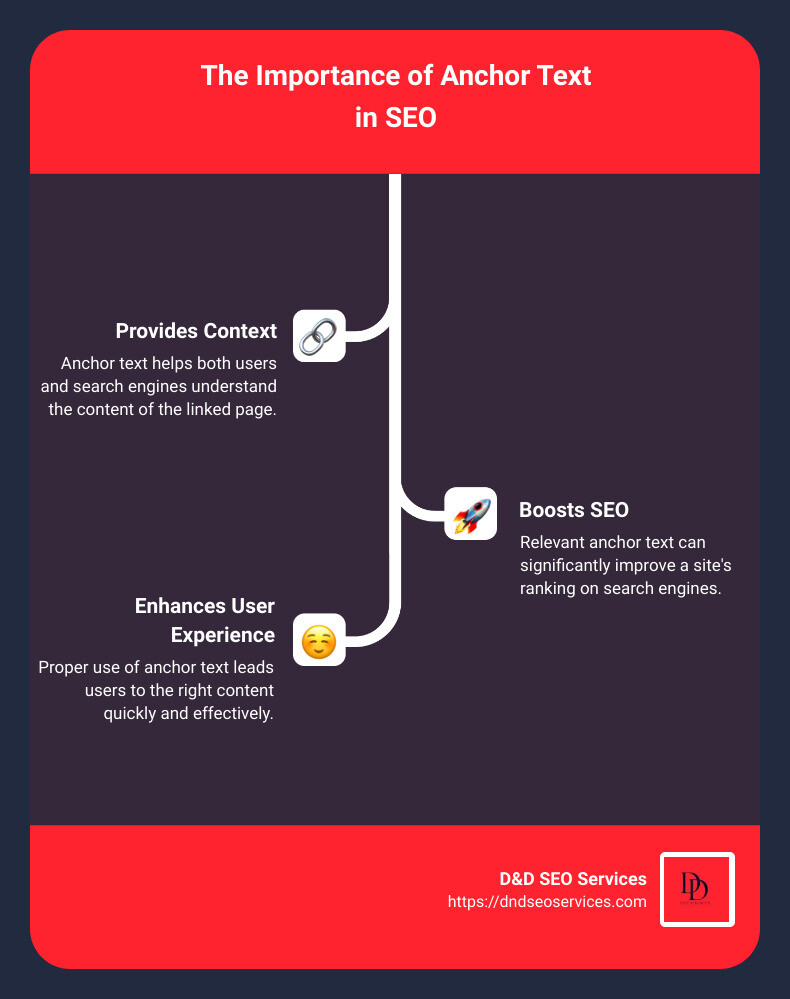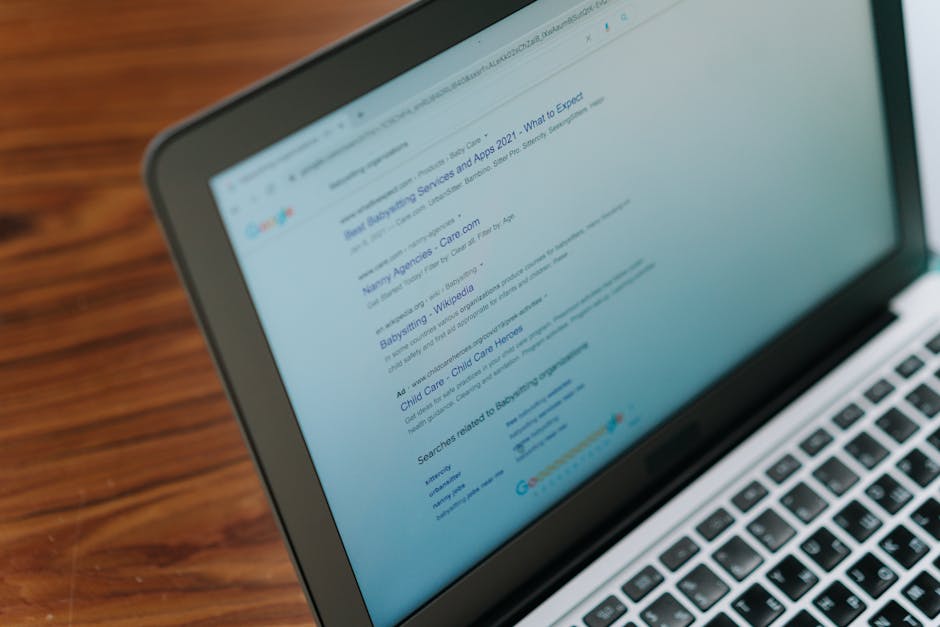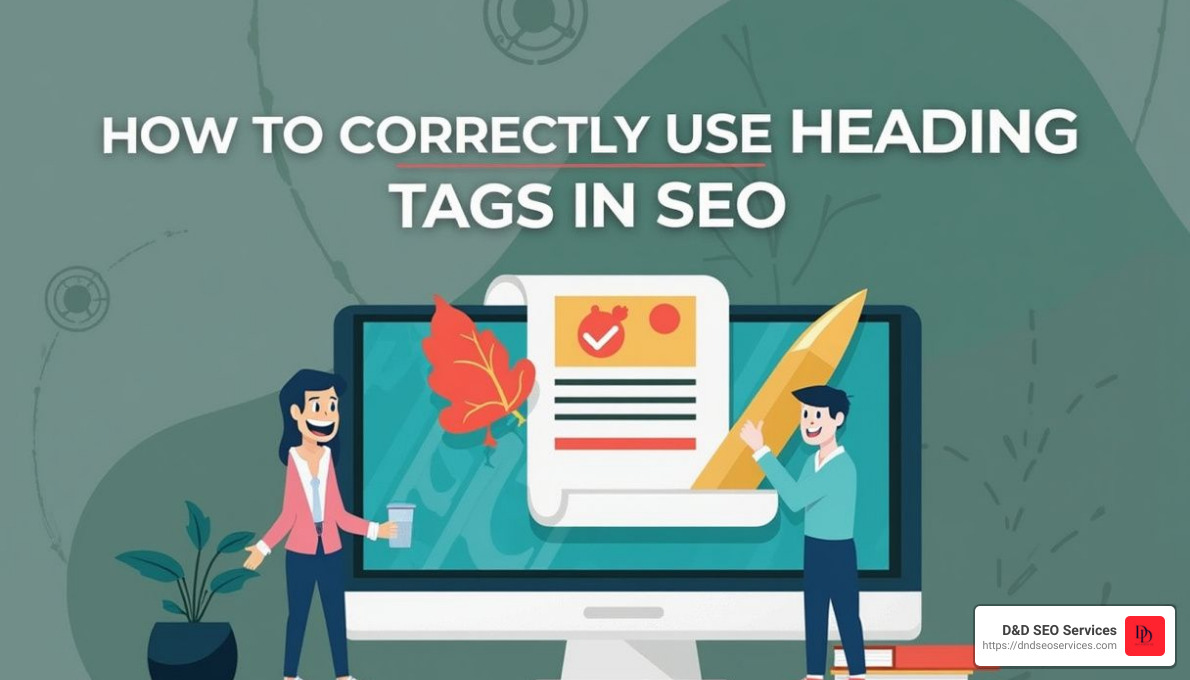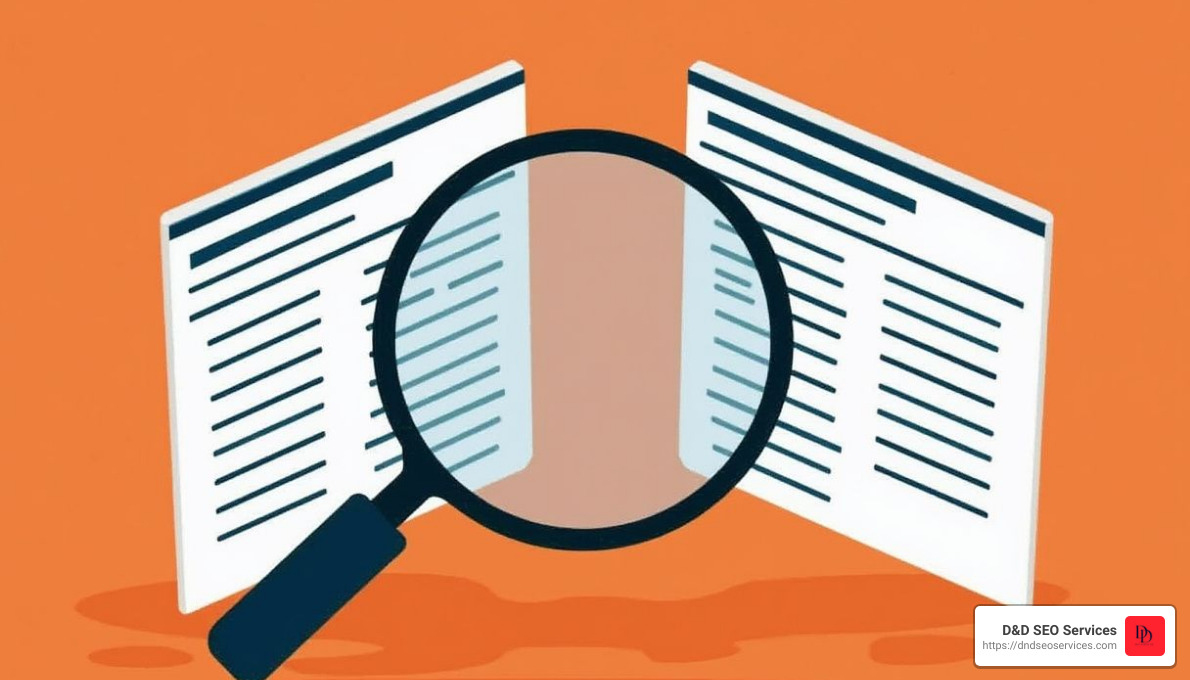Why Anchor Text is Crucial for SEO
How Important Is Anchor Text? Anchor text refers to the clickable text in a hyperlink that leads users from one webpage to another. Understanding How Important Is Anchor Text is essential for any small business owner aiming to improve their website’s visibility and search engine rankings.
Quick facts about anchor text:
- Provides context: It helps both users and search engines understand what the linked page is about.
- Boosts SEO: Relevant anchor text can improve a site’s ranking on search engines.
- Improves user experience: Proper use of anchor text can lead users to the right content quickly.
Having faced an issue where 200k spam backlinks used inappropriate anchor text, completely derailing my site’s ranking, it became evident how pivotal anchor text is in SEO. This guide will walk you through the essentials of using anchor text effectively, from types and optimization to best practices.
My name is Danielle Birriel, Founder of D&D SEO Services. For over ten years, I’ve specialized in helping businesses maximize their online presence by understanding critical elements like anchor text.
Next, we’ll dive into a more detailed look at anchor text and its role in SEO.
How Important Is Anchor Text? definitions:
- Understanding and Leveraging Latent Semantic Indexing (LSI) Keywords
- The Power of Long-Tail Keywords in SEO Content Creation
- Semantic SEO: Complete Guide to Rank Higher on Search Results
What is Anchor Text?
Anchor text is the clickable text in a hyperlink that links one webpage to another. It’s also known as link text, link label, or link title. This text is often highlighted in blue and underlined, making it stand out from the surrounding content.
Why is Anchor Text Important?
Anchor text provides context for both users and search engines. It tells users what they can expect if they click the link, and it helps search engines understand the content of the linked page. This context is crucial for improving user experience and boosting your SEO efforts.
The Anatomy of a Hyperlink
To understand where anchor text fits in, let’s break down the components of a hyperlink:
- Anchor Element Tags: These are the opening and closing tags ( and ) that create the hyperlink.
- Href Attribute: This specifies the URL of the page the link points to. It looks like this: href=”https://www.example.com”.
- Anchor Text: This is the clickable text that appears between the opening and closing anchor tags.
Here’s a simple example:
Visit Example
In this example, “Visit Example” is the anchor text.
How to Create Anchor Text
Creating anchor text is straightforward. Follow these steps:
- Start with the Opening Anchor Tag:
- Add the Href Attribute:
- Insert the Anchor Text:
Visit Example - Close the Anchor Tag:
Visit Example
For example, if you want the link to open in a new window, you can add the target attribute:
Visit Example
Using Images as Anchors
Images can also serve as anchors. Instead of placing the URL inside the opening anchor tag, you place the

The alt attribute provides a description of the image, which is useful for visually-impaired users and search engines.
Types of Anchor Text
There are various types of anchor text, each serving a different purpose:
- Exact Match: Matches the exact keyword you want to rank for.
- Phrase Match: Includes the keyword within a longer phrase.
- Partial Match: Contains a variation of the keyword.
- Branded: Uses the brand name as the anchor text.
- Generic: Uses non-descriptive text like “click here” or “read more”.
- Naked URL: The URL itself is used as the anchor text.
- Image Anchor: The image’s alt text serves as the anchor text.
Best Practices
When using anchor text, follow these best practices:
- Be Descriptive: Use text that accurately describes the linked page.
- Avoid Keyword Stuffing: Use keywords naturally and avoid overloading your anchor text.
- Keep it Short: Aim for concise and clear anchor text.

Anchor text plays a crucial role in SEO, helping search engines and users understand the content and relevance of the linked page. By using it effectively, you can improve your website’s ranking and user experience.
Next, we’ll explore the different types of anchor text in more detail.
How Important Is Anchor Text in SEO?
Anchor text is a vital component in SEO. It affects context, relevance, search engine interpretation, ranking signals, and user experience. Let’s break down why it’s so important.
Context and Relevance
Anchor text provides context for both users and search engines. When you use descriptive anchor text, it signals to search engines what the linked page is about. For example, if you link to a page about “best dog breeds for families” using that exact phrase as the anchor text, search engines understand that the linked page is relevant to those keywords.
Search Engine Interpretation
Search engines crawl the web by following links. They use anchor text to interpret the content of the linked page. For instance, if many websites link to a page using the anchor text “best hiking trails in Washington state,” search engines will associate that page with those keywords. This helps search engines rank pages more accurately.
Ranking Signal
Anchor text acts as a ranking signal. Google uses it to understand the relevance and importance of the linked page. According to a Google SEO Office Hours session, Google doesn’t trust links from spammy sites, which emphasizes the need for high-quality, relevant links. Properly optimized anchor text can boost your page’s ranking for specific keywords.
User Experience
Good anchor text improves user experience. It tells users what to expect when they click a link, making navigation more intuitive. For example, using anchor text like “learn more about our services” is more helpful than generic text like “click here.” This improves user satisfaction and can lead to higher engagement rates.
Practical Examples
- Informative Links: If you have a blog post about SEO tips, linking to a detailed guide with anchor text like “comprehensive SEO guide” helps users find more information easily.
- Product Links: On a product page, using anchor text like “buy our best-selling hiking boots” directs users to the purchase page, improving conversion rates.
- Call to Action (CTA) Links: Anchor text such as “sign up for our newsletter” encourages users to take action, boosting engagement.
Avoiding Over-Optimization
While optimizing anchor text, avoid overloading it with keywords. Over-optimization can lead to penalties from search engines. Instead, use a mix of exact match, partial match, and related keywords to keep it natural.
For example, instead of always using “best SEO tips,” vary it with phrases like “top SEO strategies” or “effective SEO methods.”
Conclusion
Anchor text is a small but mighty element in SEO. It influences context, relevance, search engine interpretation, ranking signals, and user experience. By using descriptive, varied, and user-friendly anchor text, you can improve your website’s SEO performance and user satisfaction.
Next, we’ll explore the different types of anchor text in more detail.
Types of Anchor Text
Understanding the different types of anchor text is crucial for effective SEO. Each type has its unique role and impact on your site’s ranking and user experience. Let’s dive into the most common types:
Exact Match
Exact match anchor text uses the precise keyword you want the linked page to rank for. For example, if your target keyword is “best hiking trails,” the anchor text would be exactly that: “best hiking trails”.
Example: “Check out our guide on best hiking trails for more information.”
Pro Tip: Use exact match anchor text sparingly to avoid penalties from search engines for over-optimization.
Phrase Match
Phrase match anchor text includes the target keyword as part of a longer phrase. This makes the link look more natural and provides additional context.
Example: “Learn more about the best hiking trails in the US.”
Partial Match
Partial match anchor text includes a variation of the target keyword. This approach helps diversify your anchor text profile, making it appear more natural.
Example: “Find the top trails for hiking in our latest guide.”
Branded
Branded anchor text uses your brand name as the link. This is useful for building brand recognition and authority.
Example: “For more tips, visit D&D SEO Services.”
Generic
Generic anchor text uses non-descriptive words like “click here” or “read more.” While not great for SEO, it can be useful for call-to-action buttons.
Example: “To learn more about our services, click here.”
Naked URL
Naked URL anchor text uses the actual URL as the link. This type is straightforward but not very user-friendly or SEO-effective.
Example: “Visit our blog at https://dndseoservices.com/blog.”
Image Anchor
Image anchor uses an image as the link. The alt text of the image acts as the anchor text, so make sure it’s descriptive.
Example:

Related Keywords
Related keywords anchor text uses synonyms or related terms rather than the exact target keyword. This helps search engines understand the broader context of the linked page.
Example: “Explore our guide on outdoor trips.”
Practical Usage Tips
- Balance and Diversity: Use a mix of different types of anchor text to keep your link profile natural and avoid penalties.
- Relevance: Ensure your anchor text is relevant to the linked content to improve both SEO and user experience.
- User Intent: Consider what the user expects when they click on the link and make sure your anchor text aligns with that expectation.
By understanding and strategically using these different types of anchor text, you can improve your SEO efforts and provide a better user experience.
Next, let’s explore how to optimize anchor text for even better SEO results.
How to Optimize Anchor Text for Better SEO
Optimizing anchor text is a critical part of any SEO strategy. It helps search engines understand what your linked page is about and improves user experience. Here’s how to do it effectively:
Use Relevant Keywords
Relevant keywords in your anchor text signal to search engines what the linked page is about. For example, if you have a page about “best hiking trails,” using that phrase in your anchor text can help that page rank for those keywords.
Example: “Check out our guide on best hiking trails for more information.”
Tip: Use tools like Semrush’s Organic Research tool to find relevant keywords your pages rank for.
Avoid Over-Optimization
Over-optimization occurs when you use the same exact-match anchor text repeatedly. This can trigger penalties from search engines, making your site appear spammy.
Example: Instead of always using “best hiking trails,” mix it up with variations like “top trails for hiking” or “hiking routes.”
Tip: Aim for a natural mix of exact match, phrase match, and related keywords to keep your link profile diverse.
Steer Clear of Keyword Stuffing
Keyword stuffing is the practice of overloading anchor text with keywords. This is a big no-no and can lead to penalties from search engines.
Example: Instead of saying, “Check out the best hiking trails and best hiking gear,” simplify it to, “Check out our guide on best hiking trails.”
Tip: Use keywords naturally and sparingly. Focus on providing value rather than trying to game the system.
Use Variations of Anchor Text
Variations of anchor text help create a more natural link profile. This includes using partial matches, synonyms, and related terms.
Example: Instead of always using “best hiking trails,” try “top hiking routes” or “hiking paths.”
Tip: Use tools like Google Keyword Planner to find related keywords and phrases.
Be Descriptive
Descriptive anchor text tells users and search engines what to expect when they click a link. This improves user experience and helps with SEO.
Example: Instead of “click here,” use “learn more about our hiking gear recommendations.”
Tip: Keep anchor text concise but informative. Aim for five words or less while clearly describing the linked content.
Practical Application
- Audit Your Site: Use tools like Site Audit to identify anchor text issues.
- Balance and Diversity: Mix different types of anchor text to keep your link profile natural.
- User Intent: Ensure your anchor text aligns with what users expect to find when they click the link.
By following these best practices, you can optimize your anchor text for better SEO and provide a better user experience.
Next, let’s explore the best practices for using anchor text effectively.
Best Practices for Using Anchor Text
Using anchor text effectively is key to improving your SEO and user experience. Here are some best practices to follow:
Be Succinct and Relevant
Concise and clear anchor text helps users know exactly where the link will take them. Aim to keep your anchor text to five words or less.
Example: Instead of “A comprehensive list of SEO tips and strategies,” use “SEO tips.”
Tip: Shorter anchor text is easier for users to read and understand quickly.
Maintain a Natural Flow
Your anchor text should fit naturally within the content. It should not disrupt the readability of your text.
Example: Instead of forcing, “For SEO tips and strategies,” try, “Here are some useful SEO tips.”
Tip: Write for humans first. Ensure your anchor text feels like a natural part of the sentence.
Align with Search Intent
Make sure your anchor text matches what users are looking for. If someone is searching for “knitting patterns for beginners,” your anchor text should reflect that.
Example: Use “beginner’s guide to knitting patterns” instead of just “knitting.”
Tip: Consider the reader’s intent when choosing your anchor text to improve relevance and user satisfaction.
Avoid Keyword Stuffing
Keyword stuffing can lead to penalties from search engines. Use keywords naturally and avoid overloading your anchor text.
Example: Instead of “Check out the best hiking trails and best hiking gear,” use “Check out our hiking gear recommendations.”
Tip: Focus on providing value rather than trying to game the system.
Diversify Your Anchor Text Profile
A natural link profile includes a variety of anchor texts. This means using exact matches, partial matches, and related terms.
Example: Instead of always using “best hiking trails,” mix it up with “top hiking routes” or “hiking paths.”
Tip: Use tools like Google Keyword Planner to find related keywords and phrases.
Maintain a Link Inventory
Keep track of all your links and anchor texts. This helps during optimization and site audits.
Example: Maintain a spreadsheet with columns for URLs, anchor text, and link type.
Tip: Regularly review and update your link inventory to ensure all links are optimized and relevant.
By following these best practices, you can ensure that your anchor text is effective and user-friendly.
Next, let’s dive into some frequently asked questions about anchor text.
Frequently Asked Questions about Anchor Text
How does anchor text influence ranking?
Crawler Understanding: Anchor text helps search engine crawlers understand the context of the linked page. When a crawler sees the anchor text “best hiking trails,” it knows that the linked page is likely about hiking trails.
Link Relevance: The relevance of the anchor text to the linked page is crucial. If many sites link to a page using the anchor text “blue widgets,” search engines will assume the page is about blue widgets, even if the term doesn’t appear on the page.
Keyword Matching: Using relevant keywords in anchor text can improve your page’s ranking for those terms. However, overusing exact match keywords can lead to penalties for over-optimization.
What are some benefits of good anchor text?
User Expectations: Clear and descriptive anchor text helps users understand what to expect when they click a link. This improves user experience and reduces bounce rates.
Search Engine Understanding: Properly optimized anchor text signals to search engines what the linked content is about, improving the page’s chances of ranking well for relevant keywords.
Brand Trust: Consistent and relevant anchor text can build trust with your audience. When users know what to expect from your links, they are more likely to engage with your content.
What is the issue with no anchor text?
Missed SEO Opportunity: Links without anchor text, or with generic text like “click here,” miss the chance to tell search engines what the linked page is about. This can negatively impact your SEO efforts.
Relevance Impact: Non-descriptive anchor text doesn’t provide context, making it harder for search engines to gauge the relevance of the linked page. This can hurt your ranking ability.
Ranking Ability: Without descriptive anchor text, search engines may struggle to understand the content of the linked page, leading to lower rankings in search results.
By understanding how anchor text influences ranking, the benefits of using good anchor text, and the issues with no anchor text, you can effectively optimize your SEO strategy.
Next, let’s explore the different types of anchor text and how to use them.
Conclusion
Anchor text is a vital component of any effective SEO strategy. It provides context, guides user experience, and signals to search engines what the linked content is about. By understanding and optimizing anchor text, we can significantly improve our website’s search engine ranking and user engagement.
Importance of Anchor Text
Anchor text is more than just clickable words. It is a powerful tool that helps search engines interpret the relevance and context of the linked page. For instance, if multiple sites link to a page using the anchor text “blue widgets,” search engines will understand that the linked page is highly relevant to “blue widgets.” This can help the page rank higher for that term, even if “blue widgets” isn’t explicitly mentioned on the page.
SEO Strategy
Incorporating well-optimized anchor text into our SEO strategy is essential. We should use relevant keywords naturally, avoid over-optimization, and ensure that our anchor text is descriptive and concise. This not only helps search engines understand our content better but also improves the user experience by providing clear and informative links.
D&D SEO Services
At D&D SEO Services, we specialize in creating personalized SEO strategies that leverage the power of anchor text. Our team understands the nuances of SEO and works to ensure that your website ranks higher in search results. We focus on optimizing anchor text to improve your site’s visibility and relevance.
Personalized SEO Strategies
Every business is unique, and so are its SEO needs. We tailor our strategies to meet the specific requirements of our clients. By conducting thorough keyword research and implementing best practices for anchor text, we help businesses achieve their SEO goals. Our personalized approach ensures that your website not only ranks well but also attracts the right audience.
Local Search Results in Fort Myers
For businesses in Fort Myers, local SEO is crucial. By incorporating location-specific keywords into your anchor text, we can help your business appear in local search results. This targeted approach increases your visibility among local customers who are actively searching for your services.
Anchor text plays a pivotal role in your SEO success. By understanding its importance and implementing it effectively, you can improve your website’s performance and reach your target audience more efficiently.
Ready to boost your local SEO efforts? Contact D&D SEO Services today to get started on a personalized SEO strategy that works for your business.









